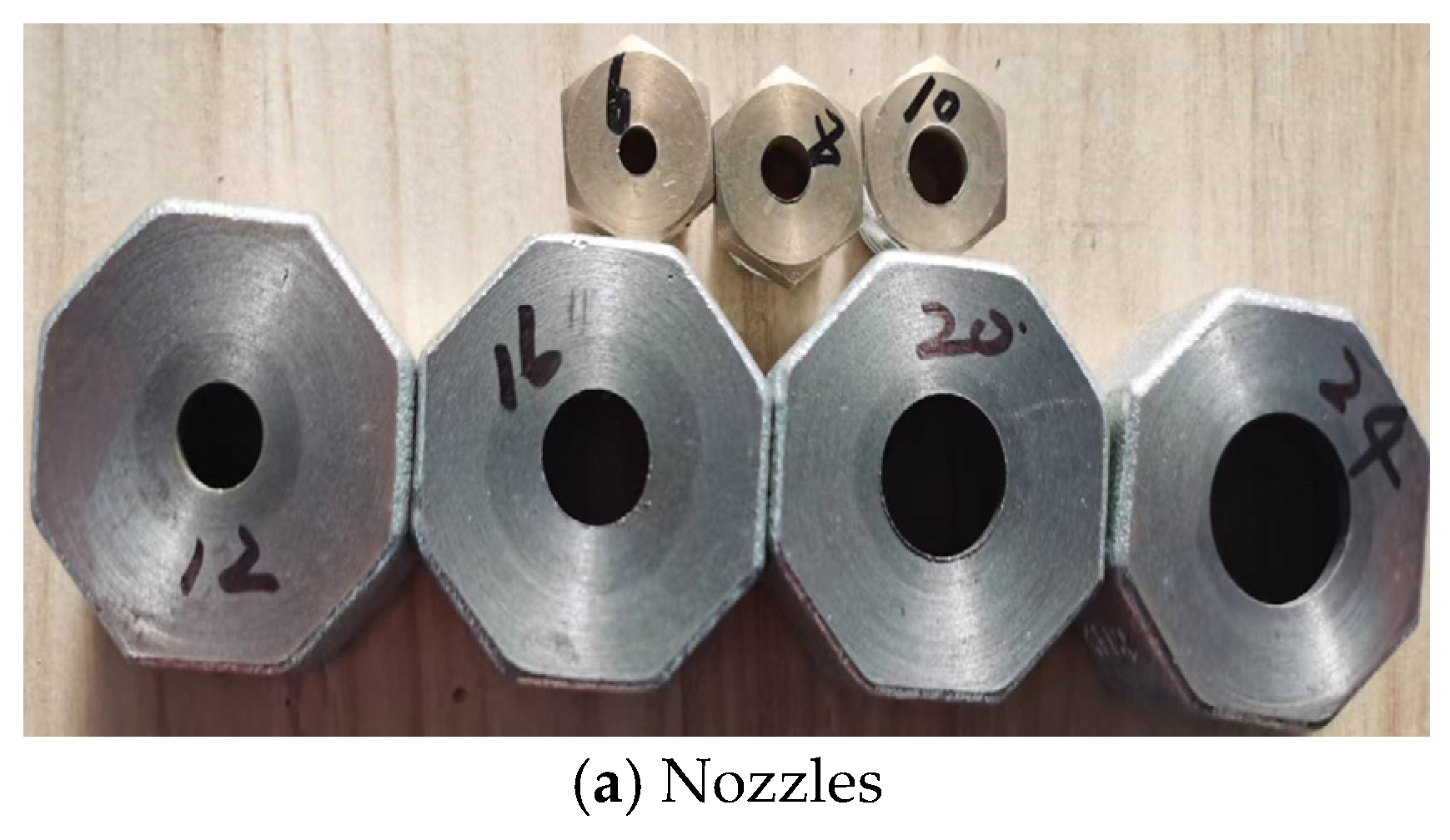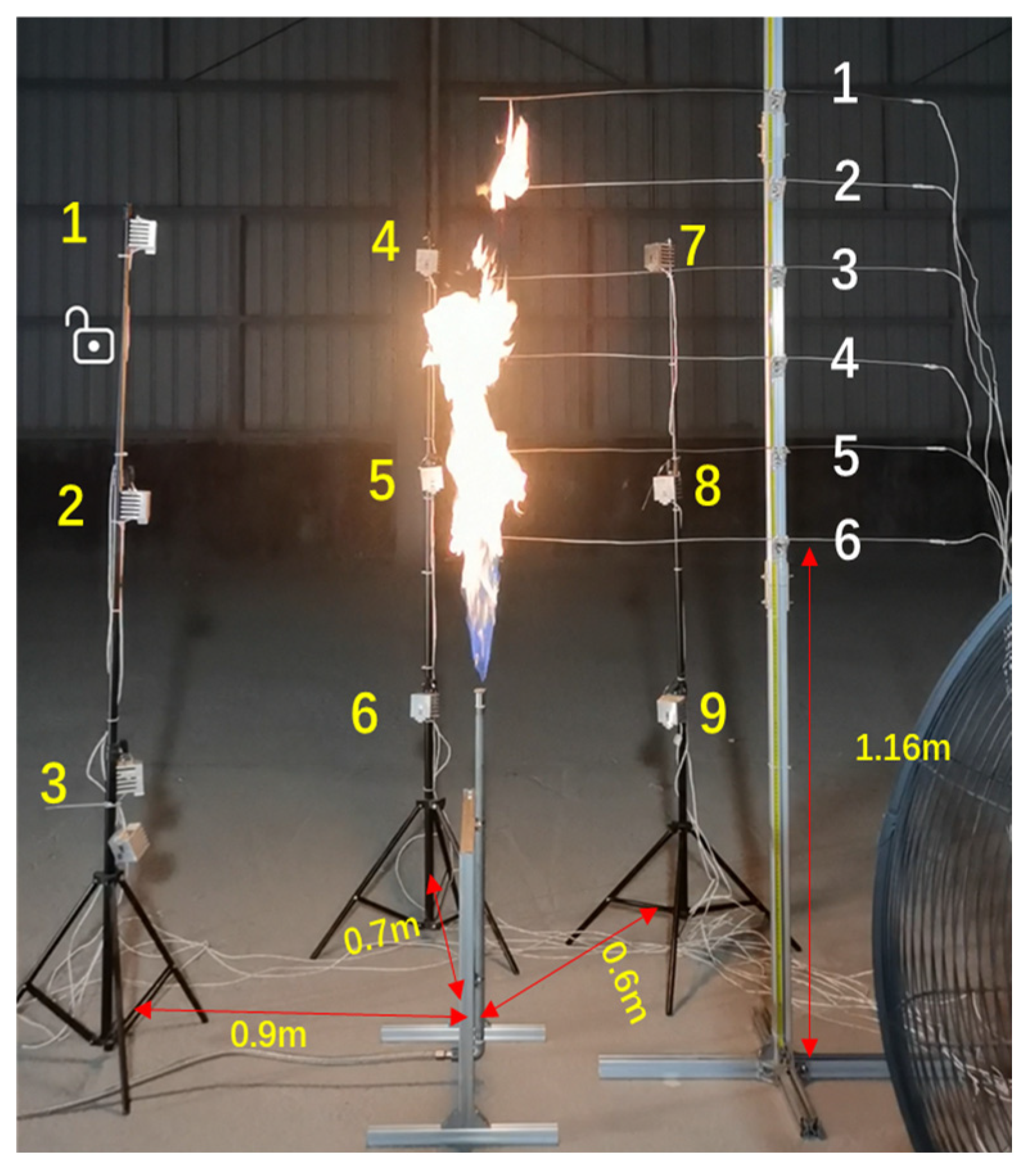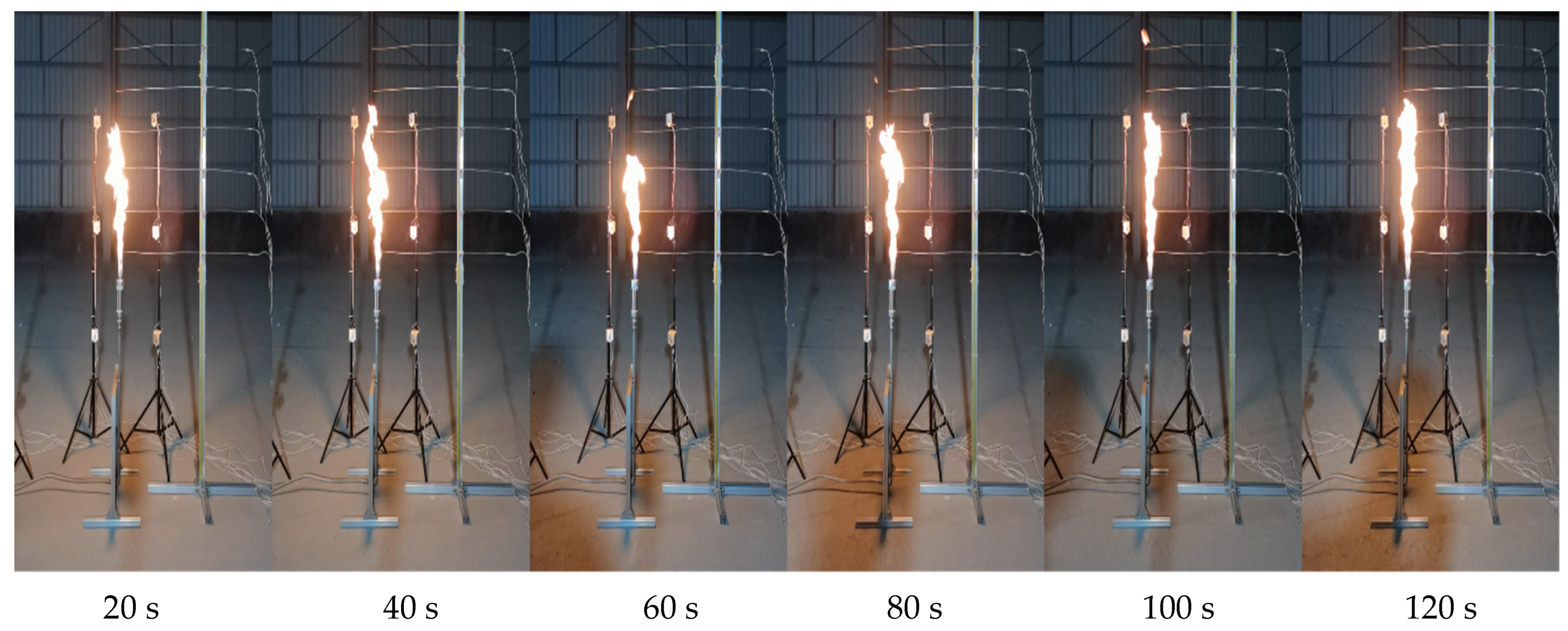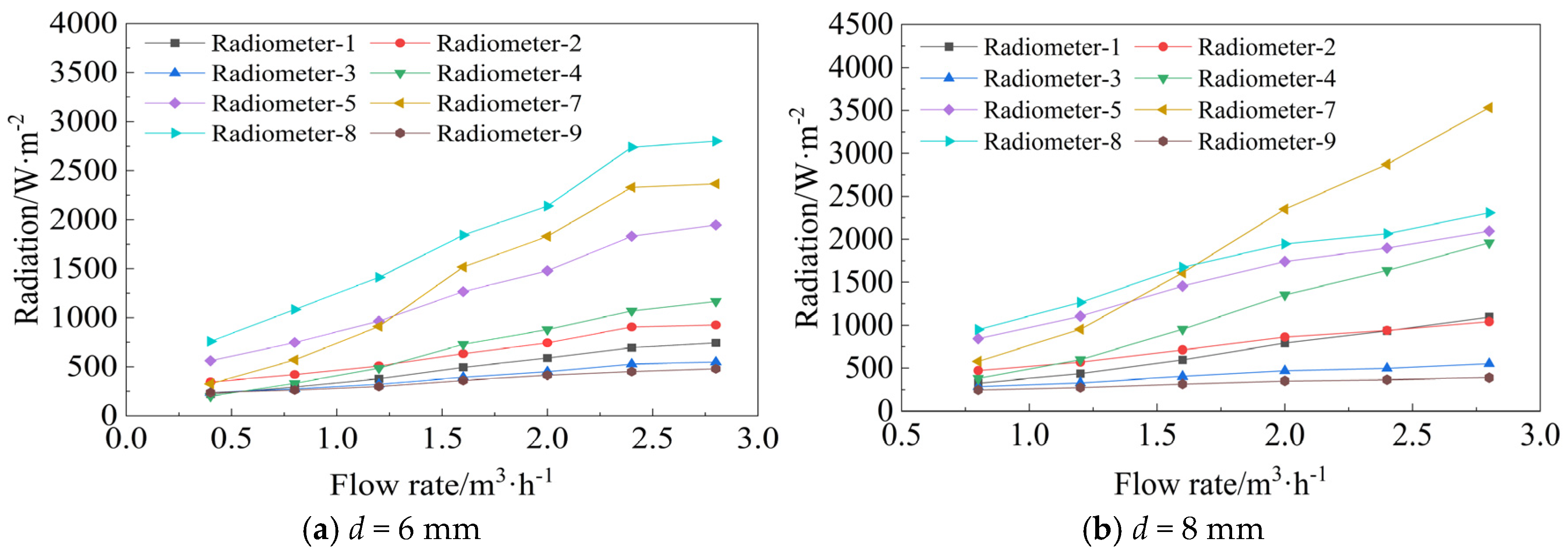Experimental Study on Combustion Characteristics of Methane Vertical Jet Flame
Abstract
1. Introduction
2. Methane Vertical Jet Flame Experiment
2.1. Experimental Setup
2.2. Data Processing
3. Experiment Results and Analysis
3.1. Effect of Methane Flow Rate and Nozzle Diameter on Jet Flame Height and Width
3.2. Effect of Methane Flow Rate and Nozzle Diameter on Jet Flame Temperature
3.3. The Effect of the Methane Flow Rate and Nozzle Diameter on the Thermal Radiation of Jet Flames
4. Conclusions
- (1)
- As the distance along the jet flame’s central axis from the nozzle increased, the temperature initially rose and then decreased. With an increase in the nozzle diameter, the position of the highest temperature along the axis fluctuated. For nozzle diameters below 16 mm, the post-peak axial temperatures displayed a positive correlation with the flow rate. In contrast, for diameters exceeding 12 mm at an axial distance of 130 mm, the local flame temperature was inversely correlated with the flow rate.
- (2)
- Both an increasing gas flow rate or nozzle diameter resulted in an upward shift in the peak thermal radiation position along the flame height. The radiation measurements revealed a distinct vertical stratification, with the upper flame region exhibiting significantly higher radiation intensities compared to the middle section. Meanwhile, the base region maintained relatively stable radiation levels and consistently recorded the lowest values among all the measured positions.
- (3)
- As the flow rate and nozzle diameter increased, the height and width of the jet flame increased. The flame’s lift-off height and shape were key factors influencing the central temperature and the distribution of the jet fire’s thermal radiation.
Author Contributions
Funding
Data Availability Statement
Conflicts of Interest
References
- Engineering Technology and Marketing Department of China National Petroleum Corporation. Compilation of Blowout Accident Cases of China National Petroleum Corporation; Petroleum Industry Press: Beijing, China, 2006. [Google Scholar]
- Yang, J.; Xu, N.; Zhou, X. Analysis on influence dimension of jet flame hazard in natural gas pipeline. Chem. Eng. Oil Gas 2022, 51, 121–126. [Google Scholar]
- Zeng, C.; Shan, Y.G. Modelling of the evolution of jet fire caused by continuous discharge of propane from a LPG Tank. J. Univ. Shanghai Sci. Technol. 2015, 37, 473–478. [Google Scholar]
- Tian, H. The lifting of the ban on deepwater oil and gas exploration in the United States has led to a surge in exploration and development in the Gulf of Mexico. Int. Pet. Econ. 2012, 1, 3. [Google Scholar]
- Yi, M. Analysis of the “6.10” Leakage and Explosion Accident in the Qinglong Section of the PetroChina China Myanmar Natural Gas Pipeline in Qianxinan Prefecture. Jilin Labour Prot. 2021, 9, 2. [Google Scholar]
- Li, Y. Research on Heat Radiation in Gas Jet Fire. China Saf. Sci. J. 2011, 21, 68–71. [Google Scholar]
- Chen, G.; Zhou, Z.; Huang, T. A validation study of the fire dynamics simulator Fluent for modeling large-scale impinging gas jet fires. Nat. Gas Ind. 2014, 34, 134–140. [Google Scholar]
- Mashhadimoslem, H.; Ghaemi, A.; Behroozi, A.H.; Palacios, A. A New simplified calculation model of geometric thermal features of a vertical propane jet fire based on experimental and computational studies. Process Saf. Environ. Prot. 2020, 135, 301–314. [Google Scholar] [CrossRef]
- Mashhadimoslem, H.; Ghaemi, A.; Palacios, A.; Behroozi, A.H. A new method for comparison thermal radiation on large-scale hydrogen and propane jet fires based on experimental and computational studies. Fuel 2020, 282, 118864. [Google Scholar] [CrossRef]
- Palacios, A.; Rengel, B. Flame shapes and thermal flux of vertical hydrocarbon flames. Fuel 2020, 276, 118046. [Google Scholar] [CrossRef]
- Palacios, A.; Muñoz, M.; Darbra, R.M.; Casal, J. Thermal radiation from vertical jet fires. Fire Saf. J. 2012, 51, 93–101. [Google Scholar] [CrossRef]
- Gore, J.P.; Faeth, G.M.; Evans, D.; Pfenning, D.B. Structure and radiation properties of large-scale natural gas/air diffusion flames. Fire Mater. 1986, 10, 161–169. [Google Scholar] [CrossRef]
- Lowesmith, B.J.; Hankinson, G. Large scale high pressure jet fires involving natural gas and natural gas/hydrogen mixtures. Process Saf. Environ. Prot. 2012, 90, 108–120. [Google Scholar] [CrossRef]
- Chen, D.; Kou, J.; Yang, R.; Zhu, J.; Zhang, Y.; Pan, J. Experiment on combustion characteristics of outdoor high pressure natural gas jet fire. Oil Gas Storage Transp. 2023, 42, 113–120. [Google Scholar]
- Zhou, B.; Liang, S.; Wang, P. Comparative analysis on influence ranges and models of thermal radiation by jet fire in well blowout. J. Saf. Sci. Technol. 2022, 18, 139–144. [Google Scholar]
- Zhou, M.; Zhou, K.; Wang, C.; Huang, M.; Wang, Y.; Jiang, J. Flame behavior of horizontal propane jet fire in a pit. CIESC J. 2022, 73, 960–971. [Google Scholar]
- Li, Y.; Liu, P.; Geng, X.; Liu, C.W.; Zhang, Y.X.; Wang, J.G. Study on Combustion Characteristics of Methane Horizontal Jet Fire with Obstacles. Oil-Gas Field Surf. Eng. 2019, 38, 7. [Google Scholar]
- Wu, Y.; Zhou, K.; Huang, M. Flame behavior of jet fire confined by the tank wall. CIESC J. 2021, 72, 2896–2904. [Google Scholar]
- Hajidavalloo, E.; Omidian, P. Modeling and simulation of flow field around a blowout well. SPE J. 2012, 17, 212–218. [Google Scholar] [CrossRef]
- Hajidavalloo, E.; Dehkohneh, S.A. Effects of perforated flow tube on the flow field of a blowout well. SPE J. 2016, 21, 1470–1476. [Google Scholar] [CrossRef]
- Zhou, Z. Study on Hazard Characteristics of Jet Fire and Domino Effect Pre-Control in Natural Gas Transmission Pipelines. Ph.D. Thesis, South China University of Technology, Guangzhou, China, 2019. [Google Scholar]










| Nozzle Diameter/mm | Gas Flow Rate/m3·h−1 |
|---|---|
| 6 | 0.4, 0.8, 1.2, 1.6, 2.0, 2.4, 2.8 |
| 8 | 0.8, 1.2, 1.6, 2.0, 2.4, 2.8 |
| 10 | 1.6, 2.0, 2.4, 2.8, 3.0 |
| 12 | 2.0, 2.2, 2.4, 2.6, 2.8, 3.2 |
| 16 | 2.0, 2.2, 2.4, 2.6, 2.8, 3.2 |
| 20 | 2.0, 2.2, 2.4, 2.6, 2.8, 3.2 |
| 24 | 2.0, 2.2, 2.4, 2.6, 2.8, 3.2 |
Disclaimer/Publisher’s Note: The statements, opinions and data contained in all publications are solely those of the individual author(s) and contributor(s) and not of MDPI and/or the editor(s). MDPI and/or the editor(s) disclaim responsibility for any injury to people or property resulting from any ideas, methods, instructions or products referred to in the content. |
© 2025 by the authors. Licensee MDPI, Basel, Switzerland. This article is an open access article distributed under the terms and conditions of the Creative Commons Attribution (CC BY) license (https://creativecommons.org/licenses/by/4.0/).
Share and Cite
Peng, Y.; Yu, J.; Chen, W.; Hao, C.; Zhang, J.; Fu, G.; Sun, B. Experimental Study on Combustion Characteristics of Methane Vertical Jet Flame. Processes 2025, 13, 1207. https://doi.org/10.3390/pr13041207
Peng Y, Yu J, Chen W, Hao C, Zhang J, Fu G, Sun B. Experimental Study on Combustion Characteristics of Methane Vertical Jet Flame. Processes. 2025; 13(4):1207. https://doi.org/10.3390/pr13041207
Chicago/Turabian StylePeng, Yudan, Jing Yu, Weifeng Chen, Chen Hao, Jiawei Zhang, Guangming Fu, and Baojiang Sun. 2025. "Experimental Study on Combustion Characteristics of Methane Vertical Jet Flame" Processes 13, no. 4: 1207. https://doi.org/10.3390/pr13041207
APA StylePeng, Y., Yu, J., Chen, W., Hao, C., Zhang, J., Fu, G., & Sun, B. (2025). Experimental Study on Combustion Characteristics of Methane Vertical Jet Flame. Processes, 13(4), 1207. https://doi.org/10.3390/pr13041207





